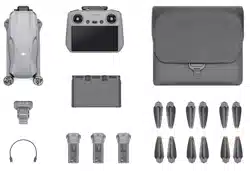Loading ...
Loading ...
Loading ...

DJI Air 3
User Manual
©
2023 DJI All Rights Reserved.
53
Original Route RTH Procedure
1. The aircraft brakes and hover in place.
2. When RTH begins:
• If the aircraft is farther than 50 m from the Home Point, the aircraft adjusts its orientation
and ies backward for 50 m on its original ight route before entering Straight Line RTH.
• If the aircraft is farther than 5 m but less than 50 m from the Home Point, it enters
Straight Line RTH.
• The aircraft lands immediately if it is less than 5 m from the Home Point.
3. The aircraft lands and the motors stop after reaching the Home Point.
The aircraft will enter or remain in Straight Line RTH if the remote controller signal is restored
during RTH.
• If the RTH is triggered through DJI Fly and the aircraft is farther than 5 m from the Home
Point, DJI Fly will display the two following options: RTH and Landing. Users can select
either RTH or directly land the aircraft.
• The aircraft may not be able to return to the Home Point normally if the GNSS signal
is weak or unavailable. The aircraft may enter ATTI mode if the GNSS signal becomes
weak or unavailable after entering Failsafe RTH. The aircraft will hover in place for a
while before landing.
• It is important to set a suitable RTH altitude before each ight. Launch DJI Fly and set
the RTH altitude. The default RTH altitude is 100 m.
• The aircraft cannot sense obstacles during Failsafe RTH if the vision systems are
unavailable.
• GEO zones may aect the RTH. Avoid ying near GEO zones.
• The aircraft may not be able to return to the Home Point when the wind speed is too
high. Fly with caution.
• Pay extra attention to small or fine objects (such as tree branches or power lines)
or transparent objects (such as water or glass) during RTH. Exit RTH and control the
aircraft manually in an emergency.
Landing Protection
If the user triggers RTH or auto landing using the remote controller or the app, Landing
Protection will activate during Smart RTH.
Landing Protection is enabled once the aircraft begins to land.
1. During Landing Protection, the aircraft will automatically detect and carefully land on
suitable ground.
2. If the ground is determined unsuitable for landing, the aircraft will hover and wait for pilot
conrmation.
3. If Landing Protection is not operational, DJI Fly will display a landing prompt when the
aircraft descends to 0.5 m from the ground. Tap conrm or push the throttle stick all the way
down and hold for one second, and the aircraft will land.
Loading ...
Loading ...
Loading ...
